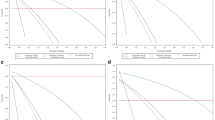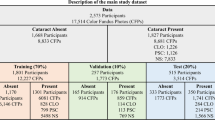Abstract
Community vision screening plays a crucial role in identifying individuals with vision loss and preventing avoidable blindness, particularly in rural communities where access to eye care services is limited. Currently, there is a pressing need for a simple and efficient process to screen and refer individuals with significant eye disease-related vision loss to tertiary eye care centers for further care. An ideal solution should seamlessly and readily integrate with existing workflows, providing comprehensive initial screening results to service providers, thereby enabling precise patient referrals for timely treatment. This paper introduces the Enhancing Community Vision Screening (ECVS) solution, which addresses the aforementioned concerns with a novel and feasible solution based on simple, non-invasive retinal photography for the detection of pathology-based visual impairment. Our study employs four distinct deep learning models: RETinal photo Quality Assessment (RETQA), Pathology Visual Impairment detection (PVI), Eye Disease Diagnosis (EDD) and Visualization of Lesion Regions of the eye (VLR). We conducted experiments on over 10 datasets, totaling more than 80,000 fundus photos collected from various sources. The models integrated into ECVS achieved impressive AUC scores of 0.98 for RETQA, 0.95 for PVI, and 0.90 for EDD, along with a DICE coefficient of 0.48 for VLR. These results underscore the promising capabilities of ECVS as a straightforward and scalable method for community-based vision screening.
Access this chapter
Tax calculation will be finalised at checkout
Purchases are for personal use only
Similar content being viewed by others
References
World Health Organization, “Increasing eye care interventions to address vision impairment,” 02 2023. https://www.who.int/publications/m/item/increasing-eye-care-interventions-to-address-vision-impairment.
R. S, F. W, G. TM, et al., “The number of ophthalmologists in practice and training worldwide: a growing gap despite more than 200, 000 practitioners,” vol. 96, no. 6, p. 783-7, 2012.
GBD 2019 Blindness and Vision Impairment Collaborators and Vision Loss Expert Group of the Global Burden of Disease Study, “Causes of blindness and vision impairment in 2020 and trends over 30 years, and prevalence of avoidable blindness in relation to VISION 2020: the right to sight: an analysis for the global burden of disease study,” Lancet Glob. Health, vol. 9, pp. e144–e160, feb 2021.
S. Resnikoff, V. C. Lansingh, L. Washburn, W. Felch, T.-M. Gauthier, H. R. Taylor, K. Eckert, D. Parke, and P. Wiedemann, “Estimated number of ophthalmologists worldwide (international council of ophthalmology update): will we meet the needs?,” British Journal of Ophthalmology, vol. 104, no. 4, pp. 588–592, 2020.
D. Milea, R. P. Najjar, J. Zhubo, D. Ting, C. Vasseneix, X. Xu, M. Aghsaei Fard, P. Fonseca, K. Vanikieti, W. A. Lagrèze, C. La Morgia, C. Y. Cheung, S. Hamann, C. Chiquet, N. Sanda, H. Yang, L. J. Mejico, M.-B. Rougier, R. Kho, T. Thi Ha Chau, S. Singhal, P. Gohier, C. Clermont-Vignal, C.-Y. Cheng, J. B. Jonas, P. Yu-Wai-Man, C. L. Fraser, J. J. Chen, S. Ambika, N. R. Miller, Y. Liu, N. J. Newman, T. Y. Wong, V. Biousse, and BONSAI Group, “Artificial intelligence to detect papilledema from ocular fundus photographs,” The New England Journal of Medicine, vol. 382, pp. 1687–1695, Apr. 2020.
Y.-C. Tham, A. Anees, L. Zhang, J. H. L. Goh, T. H. Rim, S. Nusinovici, H. Hamzah, M.-L. Chee, G. Tjio, S. Li, et al., “Referral for disease-related visual impairment using retinal photograph-based deep learning: a proof-of-concept, model development study,” The Lancet Digital Health, vol. 3, no. 1, pp. e29–e40, 2021.
T. Li, W. Bo, C. Hu, H. Kang, H. Liu, K. Wang, and H. Fu, “Applications of deep learning in fundus images: A review,” Medical Image Analysis, vol. 69, p. 101971, 2021.
X. Lei, S. Li, X. Xu, H. Fu, Y. Liu, Y.-C. Tham, Y. Feng, M. Tan, Y. Xu, J. H. L. Goh, et al., “Localizing anatomical landmarks in ocular images using zoom-in attentive networks,” pp. 94–104, 2022.
O. SM, G. MG, B. T, P. MJ, H. JD, V. DE, and E.-Z. NJ., “Implementing quality management systems to close the AI translation gap and facilitate safe, ethical, and effective health AI solutions,” NPJ digital medicine, vol. 6, no. 1, p. 218, 2023.
L. Petersson, I. Larsson, J. M. Nygren, P. Nilsen, M. Neher, J. E. Reed, D. Tyskbo, and P. Svedberg, “Challenges to implementing artificial intelligence in healthcare: a qualitative interview study with healthcare leaders in sweden,” BMC Health Services Research, vol. 22, p. 850, Jul 2022.
“Machine learning in translation,” Nature Biomedical Engineering, vol. 5, pp. 485–486, Jun 2021.
E. Baylor, E. Beede, F. Hersch, A. Iurchenko, P. Ruamviboonsuk, L. Vardoulakis, and L. Wilcox, “A human-centered evaluation of a deep learning system deployed in clinics for the detection of diabetic retinopathy,” 01 2020.
K. He, X. Zhang, S. Ren, and J. Sun, “Deep residual learning for image recognition,” in 2016 IEEE Conference on Computer Vision and Pattern Recognition (CVPR), pp. 770–778, 2016.
M. Tan and Q. V. Le, “Efficientnet: Rethinking model scaling for convolutional neural networks,” in Proceedings of the 36th International Conference on Machine Learning, ICML 2019, 9-15 June 2019, Long Beach, California, USA (K. Chaudhuri and R. Salakhutdinov, eds.), vol. 97 of Proceedings of Machine Learning Research, pp. 6105–6114, PMLR, 2019.
A. Dosovitskiy, L. Beyer, A. Kolesnikov, D. Weissenborn, X. Zhai, T. Unterthiner, M. Dehghani, M. Minderer, G. Heigold, S. Gelly, J. Uszkoreit, and N. Houlsby, “An image is worth 16x16 words: Transformers for image recognition at scale,” CoRR, vol. abs/2010.11929, 2020.
Z. Liu, H. Hu, Y. Lin, Z. Yao, Z. Xie, Y. Wei, J. Ning, Y. Cao, Z. Zhang, L. Dong, F. Wei, and B. Guo, “Swin transformer V2: scaling up capacity and resolution,” CoRR, vol. abs/2111.09883, 2021.
Zhou, Yukun and Chia, Mark A and Wagner, Siegfried K, et al., “A foundation model for generalizable disease detection from retinal images,” Nature, vol. 622, pp. 156–163, Oct. 2023.
X. Sun, H. Fang, Y. Yang, D. Zhu, L. Wang, J. Liu, and Y. Xu, “Robust retinal vessel segmentation from a data augmentation perspective,” 07 2020.
O. Ronneberger, P. Fischer, and T. Brox, “U-net: Convolutional networks for biomedical image segmentation,” in Medical Image Computing and Computer-Assisted Intervention – MICCAI 2015 (N. Navab, J. Hornegger, W. M. Wells, and A. F. Frangi, eds.), pp. 234–241, 2015.
J. Lin, L. Yu, Q. Weng, and X. Zheng, “Retinal image quality assessment for diabetic retinopathy screening: A survey,” Multimed. Tools Appl., vol. 79, pp. 16173–16199, jun 2020.
H. Fu, B. Wang, J. Shen, S. Cui, Y. Xu, J. Liu, and L. Shao, “Evaluation of retinal image quality assessment networks in different color-spaces,” MICCAI, 2019.
C. SYL, T. D, A. N, L. A, D. P, P. P, et al., “Cohort profile: design and methods in the eye and vision consortium of UK Biobank,” BMJ Open, vol. 9(2), p. e025077, 2019.
W. TY, T. YC, S. C, and C. CY., “Patterns and risk factor profiles of visual loss in a multiethnic Asian population: the Singapore Epidemiology of eye diseases study,” Am J Ophthalmol 2019;, vol. 206, pp. 48–73, 2019.
J. JB, X. L, and W. YX., “The Beijing eye study,” Acta Ophthalmologica, vol. 87, p. 247–61, 2009.
N. V, J. JB, S. A, M. A, and K. M., “Refractive error in central India: the Central India Eye and Medical Study,” Ophthalmology, vol. 117, p. 693–99, 2010.
A. K, M. P, and S. W., “Visual acuity and the causes of visual loss in australia. the blue mountains eye study,” Ophthalmology, vol. 103, p. 357–64, 1996.
S. Z, T. F, W. R, et al., “OCT angiography metrics predict progression of diabetic retinopathy and development of diabetic macular edema: a prospective study,” Ophthalmology, vol. 126, p. 1675–84, 2019.
E. Decencière et al., “Feedback on a publicly distributed image database: the Messidor database,” Image Anal. Stereol, vol. 33, p. 231–234, 2014.
O. Kovalyk et al., “Papila: dataset with fundus images and clinical data of both eyes of the same patient for glaucoma assessment,” Sci. Data, vol. 9, no. 291, 2022.
R. R. Selvaraju, A. Das, R. Vedantam, M. Cogswell, D. Parikh, and D. Batra, “Grad-cam: Why did you say that? visual explanations from deep networks via gradient-based localization,” CoRR, vol. abs/1610.02391, 2016.
K. Szczepankiewicz, A. Popowicz, K. Charkiewicz, K. Nałecz-Charkiewicz, M. Szczepankiewicz, S. Lasota, P. Zawistowski, and K. Radlak, “Ground truth based comparison of saliency maps algorithms,” Scientific Reports, vol. 13, p. 16887, Oct. 2023.
Yiming Qian, Liangzhi Li, Huazhu Fu, Meng Wang, Qingsheng Peng, Yih Chung Tham, Chingyu Cheng, Yong Liu, Rick Siow Mong Goh, Xinxing Xu, “Category-independent visual explanation for medical deep network understanding,” MICCAI, 10 2023.
M. Wang, T. Lin, L. Wang, A. Lin, K. Zou, X. Xu, Y. Zhou, Y. Peng, Q. Meng, Y. Qian, G. Deng, Z. Wu, J. Chen, J. Lin, M. Zhang, W. Zhu, C. Zhang, D. Zhang, R. S. M. Goh, Y. Liu, C. P. Pang, X. Chen, H. Chen, and H. Fu, “Uncertainty-inspired open set learning for retinal anomaly identification,” Nature Communications, vol. 14, p. 6757, Oct. 2023.
Acknowledgements
This work was supported by the Agency for Science, Technology and Research (A*STAR) under its AME Programmatic Funds (Grant Number: A20H4b0141), and its RIE2020 Health and Biomedical Sciences (HBMS) Industry Alignment Fund Pre-Positioning (IAF-PP, Grant Number: H20c6a0031).
Author information
Authors and Affiliations
Editor information
Editors and Affiliations
Rights and permissions
Copyright information
© 2025 The Author(s), under exclusive license to Springer Nature Switzerland AG
About this paper
Cite this paper
Lei, X. et al. (2025). Enhancing Community Vision Screening: AI-Driven Retinal Photography for Early Disease Detection and Patient Trust. In: Bhavna, A., Chen, H., Fang, H., Fu, H., Lee, C.S. (eds) Ophthalmic Medical Image Analysis. OMIA 2024. Lecture Notes in Computer Science, vol 15188. Springer, Cham. https://doi.org/10.1007/978-3-031-73119-8_15
Download citation
DOI: https://doi.org/10.1007/978-3-031-73119-8_15
Published:
Publisher Name: Springer, Cham
Print ISBN: 978-3-031-73118-1
Online ISBN: 978-3-031-73119-8
eBook Packages: Computer ScienceComputer Science (R0)





